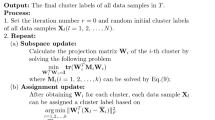Abstract
Clustering complexity increases with the number of categories and sub-categories and with data dimensionality. In this case, the distance metrics lose discrimination power with the growth of such dimensionality. Thus, we propose a multiple-module soft subspace clustering algorithm called Subspace Clustering Multi-Module Self-Organizing Maps (SC-MuSOM) that produces a map for each category. Moreover, SC-MuSOM learns a relevance coefficient for each dimension of each cluster handling the dimensionality curse. This fast-training model has a second learning stage in which the cluster prototypes are finely tuned considering the spatial resemblance between cluster centers. We validated the model with data mining sets from UCI Repository and computer vision data. Our experiments suggest that SC-MuSOM is competitive with other state-of-the-art models for the tested problems.
We thank FACEPE (Fundação de Amparo à Ciência e Tecnologia do Estado de Pernambuco) for financial support project.
Access this chapter
Tax calculation will be finalised at checkout
Purchases are for personal use only
Similar content being viewed by others
References
Assent, I.: Clustering high dimensional data. Wiley Interdisc. Rev. Data Min. Knowl. Discov. 2, 340–350 (2012)
Liu, C., Xie, J., Zhao, Q., Xie, Q., Liu, C.: Novel evolutionary multi-objective soft subspace clustering algorithm for credit risk assessment. Expert Syst. Appl. 138, 112827 (2019)
Pereira, R.B., Plastino, A., Zadrozny, B., Merschmann, L.H.: Categorizing feature selection methods for multi-label classification. Artif. Intell. Rev. 49, 57–78 (2018). https://doi.org/10.1007/s10462-016-9516-4
Araújo, A.F.R., Antonino, V.O., Ponce-Guevara, K.L.: Self-organizing subspace clustering for high-dimensional and multi-view data. Neural Netw. 130, 253–268 (2020)
Deng, Z., Choi, K.S., Jiang, Y., Wang, J., Wang, S.: A survey on soft subspace clustering. Inf. Sci. 348, 84–106 (2016)
Hammer, B., Villmann, T.: Generalized relevance learning vector quantization. J. Int. Neural Netw. Soc. 15, 1059–68 (2002)
Melchert, F., Bani, G., Seiffert, U., Biehl, M.: Adaptive basis functions for prototype-based classification of functional data. Neural Comput. Appl. 32, 18213–18223 (2020). https://doi.org/10.1007/s00521-019-04299-2
Schneider, P., Biehl, M., Hammer, B.: Adaptive relevance matrices in learning vector quantization. Neural Comput. 21, 3532–3561 (2009)
Hammer, B., Schleif, F.M., Villmann, T.: On the generalization ability of prototype-based classifiers with local relevance determination. Citeseer (2005)
Bassani, H.F., Araújo, A.F.R.: Dimension selective self-organizing maps for clustering high dimensional data. In: The International Joint Conference on Neural Networks, pp. 1–8. IEEE (2012)
Bassani, H.F., Araújo, A.F.R.: Dimension selective self-organizing maps with time-varying structure for subspace and projected clustering. IEEE Trans. Neural Netw. Learn. Syst. 26(3), 458–471 (2015)
Attaoui, M.O., Attaoui, M.O., Azzag, H., Lebbah, M., Keskes, N.: Subspace data stream clustering with global and local weighting models. Neural Comput. Appl. 33(8), 3691–3712 (2021). https://doi.org/10.1007/s00521-020-05184-z
Araújo, A.F.R., Rego, R.L.: Self-organizing maps with a time-varying structure. ACM Comput. Surv. 46(1), 7:1–7:38 (2013)
Hua, W., Lingfei, M.: Clustering ensemble model based on self-organizing map network. Comput. Intell. Neurosci. 2020 (2020)
Shahi, K.R., et al.: Hierarchical sparse subspace clustering (HESSC): an automatic approach for hyperspectral image analysis. Remote Sens. 12(15), 2421 (2020)
Mishne, G., Talmon, R., Cohen, I., Coifman, R.R., Kluger, Y.: Data-driven tree transforms and metrics. IEEE Trans. Sig. Inf. Process. Netw. 4(3), 451–466 (2017)
Goren-Bar, D., Kuflik, T.: Supporting user-subjective categorization with self-organizing maps and learning vector quantization. J. Am. Soc. Inf. Sci. Technol. 56(4), 345–355 (2005)
Rahutomo, F., Kitasuka, T., Aritsugi, M.: Semantic cosine similarity. In: International Student Conference on Advanced Science and Technology, ICAST, vol. 4, no. 1 (2012)
Dua, D., Graff, C.: UCI machine learning repository (2017). https://archive.ics.uci.edu/ml/index.php
Hull, J.J.: A database for handwritten text recognition research. IEEE Trans. Pattern Anal. Mach. Intell. 16(5), 550–554 (1994)
Fei-Fei, L., Perona, P.: A Bayesian hierarchical model for learning natural scene categories. In: 2005 IEEE Computer Society Conference on Computer Vision and Pattern Recognition, vol. 2, pp. 524–531 (2005)
Fei-Fei, L., Fergus, R., Perona, P.: Learning generative visual models from few training examples: an incremental bayesian approach tested on 101 object categories. In: Conference on Computer Vision and Pattern Recognition Workshop, p. 178 (2004)
Wu, J., Lin, Z., Zha, H.: Essential tensor learning for multi-view spectral clustering. IEEE Trans. Image Process. 28(12), 5910–5922 (2019)
Simonyan, K., Zisserman, A.: Very deep convolutional networks for large-scale image recognition. In: International Conference on Learning Representations (2015)
Author information
Authors and Affiliations
Corresponding author
Editor information
Editors and Affiliations
Rights and permissions
Copyright information
© 2022 The Author(s), under exclusive license to Springer Nature Switzerland AG
About this paper
Cite this paper
da Silva Júnior, M.R., Araújo, A.F.R. (2022). Subspace Clustering Multi-module Self-organizing Maps with Two-Stage Learning. In: Pimenidis, E., Angelov, P., Jayne, C., Papaleonidas, A., Aydin, M. (eds) Artificial Neural Networks and Machine Learning – ICANN 2022. ICANN 2022. Lecture Notes in Computer Science, vol 13532. Springer, Cham. https://doi.org/10.1007/978-3-031-15937-4_24
Download citation
DOI: https://doi.org/10.1007/978-3-031-15937-4_24
Published:
Publisher Name: Springer, Cham
Print ISBN: 978-3-031-15936-7
Online ISBN: 978-3-031-15937-4
eBook Packages: Computer ScienceComputer Science (R0)




